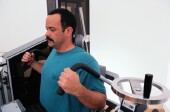
SATURDAY, Feb. 23 (HealthDay News) — People with heart disease who want to exercise should first get the OK from their doctor and then follow certain health and safety measures, according to the American Council on Exercise.
Every exercise session should include at least a five-minute warm-up and five-minute cool-down, which reduces the risk of oxygen deprivation to the heart in response to sudden physical effort or an abrupt end to exercise, the council advised in a recent news release.
Do moderate-intensity exercise, such as brisk walking, for at least 30 minutes on most — and preferably all — days of the week.
People with heart disease need to closely monitor their exercise intensity and stay within their individual heart-rate zone, which is typically determined from a treadmill test conducted under the supervision of a doctor.
Be cautious about doing vigorous exercise. If you plan to start a vigorous exercise program, discuss it with your doctor and be sure to complete an exercise stress test first, the council said.
Tell your trainer and doctor if you have any abnormal signs or symptoms before, during or after exercise. These include: chest pain, extreme fatigue, indigestion or heartburn, excessive breathlessness, ear or neck pain, upper respiratory tract infection, dizziness or racing heart, and severe headache.
If you have been prescribed nitroglycerin, be sure to always carry it with you during exercise. Never exert yourself to the point of developing chest pain. If you do experience chest pain, call 911 immediately.
Be sure that your exercise facility is well equipped in case of a heart emergency. Ask if it has an emergency response plan and an automated external defibrillator and staff who know how to use it.
More information
The MedlinePlus Medical Encyclopedia has more about people with heart disease and exercise.

